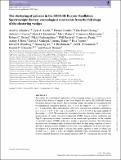The clustering of galaxies in the SDSS-III Baryon Oscillation Spectroscopic Survey : cosmological constraints from the full shape of the clustering wedges
Abstract
We explore the cosmological implications of the clustering wedges, ξ⊥(s) and ξ∥(s), of the CMASS Data Release 9 sample of the Sloan Digital Sky Survey III (SDSS-III) Baryon Oscillation Spectroscopic Survey. These clustering wedges are defined by averaging the full two-dimensional correlation function, ξ(μ, s),over the ranges 0 <μ <0.5 and 0.5 <μ <1,respectively. These measurements allow us to constrain the parameter combinations DA(z)/rs(zd) = 9.03± 0.21 and cz/(rs(zd)H(z)) = 12.14 ±0.43 at the mean redshift of the sample, z = 0.57. We combine the information from the clustering wedges with recent measurements of cosmic microwave background (CMB), baryon acoustic oscillations and TypeIa supernovae to obtain constraints on the cosmological parameters of the standard Λ cold dark matter (ΛCDM) model and a number of potential extensions. The information encoded in the clustering wedges is most useful when the dark energy equation of state is allowed to deviate from its standard ΛCDM value. The combination of all data sets shows no evidence of a deviation from a constant dark energy equation of state, in which case we find wDE = -1.013± 0.064, in complete agreement with a cosmological constant. We explore potential deviations from general relativity (GR) by constraining the growth rate f(z) = d ln D(a)/d ln a, in which case the combination of the CMASS clustering wedges with CMB data implies f(z =0.57) = 0.719-0.096+0.092, in accordance with the predictions of GR. Our results clearly illustrate the additional constraining power of anisotropic clustering measurements with respectt o that of angle-averaged quantities.
Citation
Sánchez , A G , Kazin , E A , Beutler , F , Chuang , C-H , Cuesta , A J , Eisenstein , D J , Manera , M , Montesano , F , Nichol , R C , Padmanabhan , N , Percival , W , Prada , F , Ross , A J , Schlegel , D J , Tinker , J , Tojeiro , R , Weinberg , D H , Xu , X , Brinkmann , J , Brownstein , J R , Schneider , D P & Thomas , D 2013 , ' The clustering of galaxies in the SDSS-III Baryon Oscillation Spectroscopic Survey : cosmological constraints from the full shape of the clustering wedges ' , Monthly Notices of the Royal Astronomical Society , vol. 433 , no. 2 , pp. 1202-1222 . https://doi.org/10.1093/mnras/stt799
Publication
Monthly Notices of the Royal Astronomical Society
Status
Peer reviewed
ISSN
0035-8711Type
Journal article
Collections
Items in the St Andrews Research Repository are protected by copyright, with all rights reserved, unless otherwise indicated.

